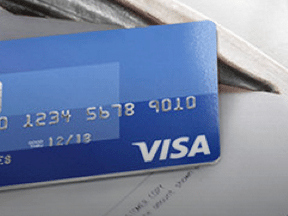Ecommerce business owners dread credit card chargebacks. It often takes just one chargeback for a merchant to question her procedures, to stop another one from happening. Luckily, if you prepare ahead of time, a chargeback, while never fun, can be prevented.
So, how does a business owner, especially one that never meets her customers, protect from chargebacks?
Reality of Credit Card Chargebacks
When a business owner enters into an agreement with a credit card processor, that processor typically forwards the amount of any credit card payments made by the buyer to the merchant within three business days. However, a buyer may dispute the charge for some time after the purchase — it varies by state law but is generally around 90 days after the purchase.
… a buyer may dispute the charge for some time after the purchase — it varies by state law but is generally around 90 days after the purchase.
In most cases, the buyer makes one of three claims in a chargeback: (a) the buyer didn’t actually purchase the items and the credit card was used fraudulently; (b) the buyer didn’t receive the items ordered; or (c) the buyer did receive the items but they weren’t as described. When the buyer disputes a purchase, the dispute or chargeback process begins and the merchant must prove that the buyer received the legitimate items.
Once a dispute is initiated, most credit card processors take back the money that was paid to the merchant and hold the money until the dispute is resolved. The processor asks the merchant for proof that the buyer’s claims are false, as the buyer is usually believed to be truthful unless proven otherwise. After receiving the information from the merchant, the processor determines whether the merchant should receive the money or whether the claim was justified. Depending on the type of claim made — fraud, didn’t receive items, improper descriptions — the documentation may vary that can help a merchant win his case.
Protecting Against Chargebacks
To help protect against all claim types, merchants should display good terms of use and a good privacy policies on their websites. Require a shopper — prior to making any purchases — to check a box (which links to both agreements) that states she has read and agrees to these agreements. These documents need to have clear language about shipping procedures, return policies, and what data is collected about users on the site. For more, see “6 Key ‘Terms and Conditions’ for Ecommerce Merchants” and “How to Create an Ecommerce Privacy Policy.”
- To help dispute accusations of fraud, a merchant should use a good platform or analytics program to capture the IP address, location, date, and time of each purchase on the site. Prior to sending orders, especially high dollar orders, a merchant should confirm that the location of the buyer matches the information on the buyer’s credit card and shipping address.
For example, if a buyer claims the billing address is in Denver, but the location (via IP address) of where the purchase was actually made and the shipping address are Austin, this should raise red flags and warrant further inquiry. In some cases, you may even want to match the name on the credit card to the owner’s address using public records.
Unless you regularly ship internationally, investigate all international orders prior to shipping. Investigations may include actual conversations with the buyer, additional email discussions with the buyer, not accepting any order from certain countries known for fraud, lowering the amount of the first shipment, and requiring cash on delivery or wire transfers rather than accepting credit cards.
- To help dispute charges of not receiving the product, merchants should have standard written shipping procedures that they use to mail all products. This could include specifics about how items are packaged, what type of insurance is used, and when delivery confirmation is required. For high dollar orders, insurance should always be required as part of the mailing costs and deliveries should always require a signature prior to release of the package. For low dollar orders, insurance and signature confirmation is only required when the merchant knows that a chargeback may occur and is willing to absorb the costs of such a chargeback as part of doing business.
- To help dispute charges of receiving the wrong product, it may be best to have video or still images of all products shipped. If a merchant has a shipping department, this department may need to have a video camera in it to show what is packaged for each customer. If a merchant does not have a shipping department, images should be taken of high dollar orders and of any suspicious orders — if these get shipped at all.
Merchants should also take care to make sure items are accurately described on the website. If the size or specifications of items are inconsistent, this should clearly stated and possibly acknowledged with a checkbox during the ordering procedure. For instance, art and handmade goods are typically not consistent and may require an acknowledgement that the actual imagery changes each time.
Communicate with Buyer
To help dispute charges of fraud, not receiving a product, or receiving a wrong product, communication with the buyer after he receives the product is key — you should receive a delivery confirmation if you have proper shipping procedures in place. An easy way to confirm receipt of the product, and have documentation in case of a dispute, is to send an email with a survey (assuming your survey program can track who responds and what their responses were).
For example, if a buyer states that he received the item and rates it as “good,” a merchant has proof that the item was received and liked, assuming that the email address is really the buyer’s – if not, then fraud may be involved. You can also request information about what the buyer liked or disliked about the process; this helps you in your future marketing and also can be used in a dispute procedure if the buyer rated you highly.
To help dispute charges of fraud, not receiving a product, or receiving a wrong product, communication with the buyer after he receives the product is key…
If a buyer initiates a chargeback, having accurate and professional records helps. If you have followed the steps above, you will have the agreements that are in place, IP location records, shipping procedures, confirmation receipts, and communication with the buyer after the sale.
Send this information to the credit card process to show that the buyer really did purchase and receive the item. By having a procedure in place and then following it for all sales, your business is in the best possible stance to protect against chargebacks, both by preventing them and giving you a defense if they happen.





